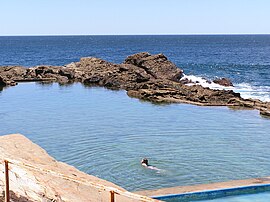Bermagui, New South Wales
| Bermagui New South Wales | |
|---|---|
 The Blue Pool at Bermagui | |
| Population | 1,298 (2006 census)[1] |
| Postcode(s) | 2546 |
| LGA(s) | Bega Valley Shire |
Bermagui is a town on the south coast of New South Wales, Australia in the Bega Valley Shire. The name is derived from the Dyirringanj word, permageua,[2] possibly meaning 'canoe with paddles'.[3]
It is said that offshore from Bermagui the continental shelf is at its closest point to the mainland and hence there is good fishing.[4] This closeness of the continental shelf also means that Bermagui is renowned for cold currents, and sudden changes in water temperature.
A wharf was built at Bermagui in the 1870s for the coastal trade. The port was serviced by the Illawarra Steam Navigation Company.[5]
A 1910 article, 'Bermagui - In a Strange Sunset', published by Henry Lawson in The Bulletin describes a steamer journey from Bermagui to Sydney. Lawson was probably travelling with the Illawarra Steam Navigation Company.
In 1880, a geologist, Lamont Young, and four others disappeared while on a boat trip from Bermagui. Their boat was found near Mystery Bay, which is about 15 kilometres north of Bermagui, midway between Bermagui and Narooma, near Tilba. The bay received its name because of the disappearance.
Zane Grey, the well-known big-game fisherman of the 1930s and author of Westerns, wrote of his experiences there. He was patron of the Bermugui Sport Fishing Association for 1936/37 and anchored his yacht, the "Avalon" in Horseshoe Bay.

In 1943, the Japanese submarine I-21 sank the iron ore carrier SS Iron Knight off the coast of Bermagui. Local fisherman had tangled their nets on the wreck deep below the surface in 125 metres of water, but did not know the ship lay there until a team of divers confirmed its existence on June 4, 2006. On July 29, 2006 relatives and descendants of the ships crew came to Bermagui for a memorial and commemorative service.[6]
During the 1940s and 1950's the detective writer Arthur Upfield lived in the town and made it the setting for one of his novels, "The Mystery of Swordfish Reef", published in 1943.
A fishing harbour was built at Bermagui in 1959, the first in a new series by the Public Works Department.[5]
Outdoor scenes from the film "The Man Who Sued God" starring Billy Connolly were shot in Bermagui Harbour.[7]
Over the Christmas break 2004/2005, the Leader of the Opposition, Mark Latham retreated here from the media and decided to resign as ALP leader and from Parliament remarking in his biography, "Thank God for Bermagui".
See also
References
- ^ Australian Bureau of Statistics (25 October 2007). "Bermagui (Urban Centre/Locality)". 2006 Census QuickStats. Retrieved 13 June 2009.
- ^ "Bermagui". SMH. February 8, 2004. Retrieved 2007-01-19.
- ^ "Bermagui". Geographical Names Board of New South Wales. Retrieved 13 June 2009.
- ^ "Bermagui". Sapphirecoast.info. 2005. Retrieved 2007-01-19.
- ^ a b "Bermagui". Maritime Heritage Online. NSW Department of Planning - Heritage Office. Retrieved 2006-12-18.
- ^ Yourguide, Narooma site, news article from Wednesday 9 August 2006.
- ^ Filming Locations for The Man Who Sued God, IMDb. Retrieved W13 January 2006.
External links
- Information about Bermagui
- Sapphire Coast tourism site article on Bermagui
- Morningside's TravelSouth visitors guide article on Bermagui
- Grey, Zane (1937). An American Angler in Australia. The Derrydale Press (Now part of the Rowman & Littlefield Group). ISBN 9781564162045.
